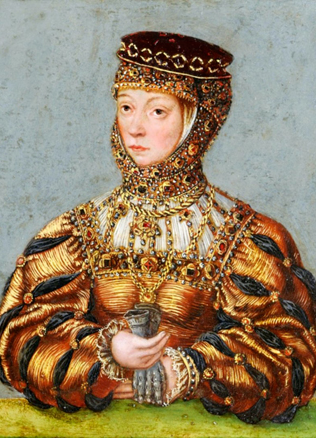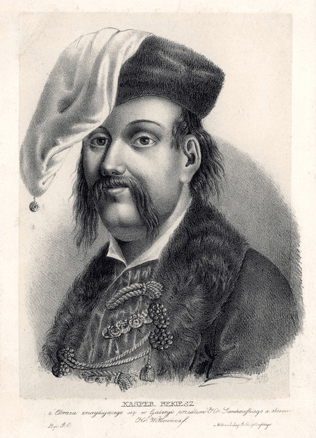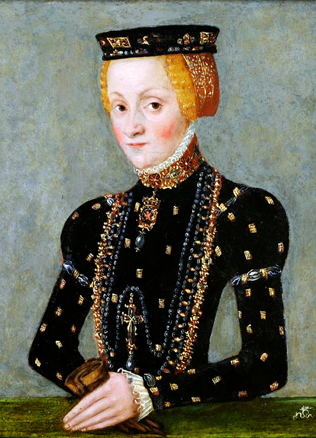Chodkevičiai (The Chodkiewicz) – “the new Lithuanians”
The name of Chodkevičiai is mentioned in the historical sources late, at the beginning of the 15th century when their ancestor Chodka Jurjevičius (Jurjewicz) testified in the 1422 Treaty of Melno with the Teutonic Order as the Elder of Polock. That was a great achievement for an Orthodox believer because, according to the 1387 and 1413 privileges, the rights of the noblemen were recognised and state offices could be given only to the persons belonging to the Catholic faith. We do not know on account of what merits this exception was made for Chodka but from then the history of the rise and intermingling with other noblemen of the Grand Duchy of Lithuania began. Chodka’s son Jonas (Ivan) Chodkevičius served in the court of King of Poland and Grand Duke of Lithuania Casimir Jagiellonczyk in Cracow in his youth, later he became noted for defending Kiev against the attacks of the Tartars. He died tragically in the captivity of the Tartars in 1482, and his wife and their son were liberated from captivity with great efforts of the envoys of the Grand Duchy of Lithuania. Casimir’s decision to entrust ruling of Kiev to Chodkevičius, who had demonstrated loyalty and faithfulness, but was of modest origin, caused dissatisfaction of the Dukes Olelkaičiai who reigned in that part of the country for a long time and took pride in their Gediminids genealogy and who ironically called the Chodkevičiai their former servants. Jonas Chodkevičius’ climbing the ladder of social hierarchy was testified to by the fact that another Gediminid and the Ruler’s relative – Duke of Bielsk married off his daughter to him. Everything changed some generations later – in the 16th century the Chodkevičiai found themselves among the families of the magnates of the Grand Duchy of Lithuania. The Chodkevičai had to adapt themselves to politically dominant magnates of Lithuanian origin in that country.
Rudiments of the Church Union
The Orthodox faith professed by the Chodkevičiais posed the main obstacle to their career for a long time.
At the beginning of the 16th century, in Supraśl, a secluded location of Podlachia, onas Chodkevičius’ son Aleksandras founded a monastery, which became a spiritual and political centre of the family. The pantheon of the members of the family appeared in Supraśl; the members of the family felt belonging to a viable community of close people there, by means of the monks’ prayers their remembrance and by writing (chronicles of the family) their historical memory were cherished. In the long run Supraśl became an important centre of Orthodox culture of the Grand Duchy of Lithuania in which one of the largest spiritual projects of the 16th century was completed –the Holy Writ was translated into the Ruthenian language.
“
The Orthodox faith professed by the Chodkevičiais posed the main obstacle to their career for a long time.
The magnates considered it to be a secondary consequence of the activity of the monastery. Supraśl was a part of the family and the church policy for the Chodkevičiai. From the times of Jogaila and Vytautas the initiatives to create the Church Union and build the road for the rapprochement of the Catholic and Orthodox faiths were constantly renewed. Though at an official level the Church Union did not take place at that time yet, the ideas of creating the Church Union found resonance in the estates of some Orthodox magnates and the gentry. Constantly communicating with the Catholics, belonging to their estate, they gradually adapted themselves culturally to their surroundings. The example of cultural integration is the Orthodox Church of Supraśl built by the Chodkevičiai. The construction of Gothic style that was alien to the Byzantine Orthodox civilisation represented the type of gothic Orthodox churches that was wide-spread in the Grand Duchy of Lithuania. These Orthodox churches built on the border of the Orthodox believers and Catholics reflected the aspiration of the Orthodox nobility to develop the idea of the Union as an informal self of the local church.
“
The family of Ruthenian origin became Lithuanian.
However, in the 16th century the Church Union was still a vague perspective of the future, and the possibilities of a political career were opening wider. Therefore the Chodkevičiai had to change their faith. Their conversion coincided with the spread of Reformation in Lithuania therefore at first the Chodkevičiais became Protestants and only in the second half of the 16th century, like many other Lithuanian magnates, they converted to Catholicism. The family of Ruthenian origin became Lithuanian. Alongside the offices they occupied in the Ruthenian lands they began to rule in Lithuania ever more often.
Identity beyond the ethnos and religion
In his 1574 letter to Mikalojus Radvila “the Brown” (Mikołaj Radziwiłł Rudy) the Elder of Samogitia Jonas Chodkevičius wrote the following: “We, Lithuania”. This is how he characterised the Chodkevičiai belonging to the nation of the Lithuanian nobility. The roots of the Ruthenian family went into oblivion and the historians of that time, beginning with Motiejus Strijkovskis (Maciej Stryjkowski) recorded the “genealogical discovery”. According to the chronicler, the ancestor of the Chodkevičiai was a Lithuanian, named Boreika, who, on commission of the Grand Duke went (later Albertas Vijūkas-Kojalavičius will supplement that he was noted for fast walking therefore he was nicknamed “Chodka”) to rule the Russian lands. Thus self-awareness of the nobility adapted itself to the changed status of the family and the political circumstances. The Chodkevičiai became the same Lithuanians as the Radvilos (Radziwiłłs) with whom they competed and were related. Their residences built side by side in Vilnius in 1600 even became the arena of the internal struggle during which Jonas Karolis Chodkevičius (Jan Karol), who later became a famous military leader, tested the skills of military tactics. The conflict broke out over the dowry of the last princess of Sluck, Sofija Olelkaitė.
“
All of them were members of the nation of the nobles, and different origin or even confessions did not prevent them from feeling a part of one Lithuanian community (though speaking Polish already).
Such conflicts rarely grew into long-lasting discords. Political and social interests united rather than separated these magnates, and made them seek for joint solutions. All of them were members of the nation of the nobles, and different origin or even confessions did not prevent them from feeling a part of one Lithuanian community (though speaking Polish already). The Chodkevičiai were citizens of the Grand Duchy of Lithuania who found their residences in distant places like over the Dnieper like (Bychov) or Samogitia (Šaukėnai, Kretinga) as valuable as in the centre of the state – Vilnius. The case was similar with the issue of faith. Jonas Karolis Chodkevičius built a Uniate church for his Bychov subordinates and introduced an obligatory duty for them to attend it. When he was afflicted with ailment he expected a miracle upon arriving at the place of Orthodox pilgrimage in Zhirovichi, and at the same time he founded two centres of Catholic faith and education that later became famous in Samogitia – Kražiai College of Jesuits and the Bernardine (franciscan observants) Monastery in Kretinga. There they were considered to be the people of these places too. In the 17th century, the Samogitians called Jonas Karolis Chodkevičius, who crushed the Swedes, “Katkus” and sang as follows about him: Mūsų Katkus labai drūts, / Tikras buvo karaliuks (“Our Katkus is really robust, he was a real king”).
Rimvydas Petrauskas



